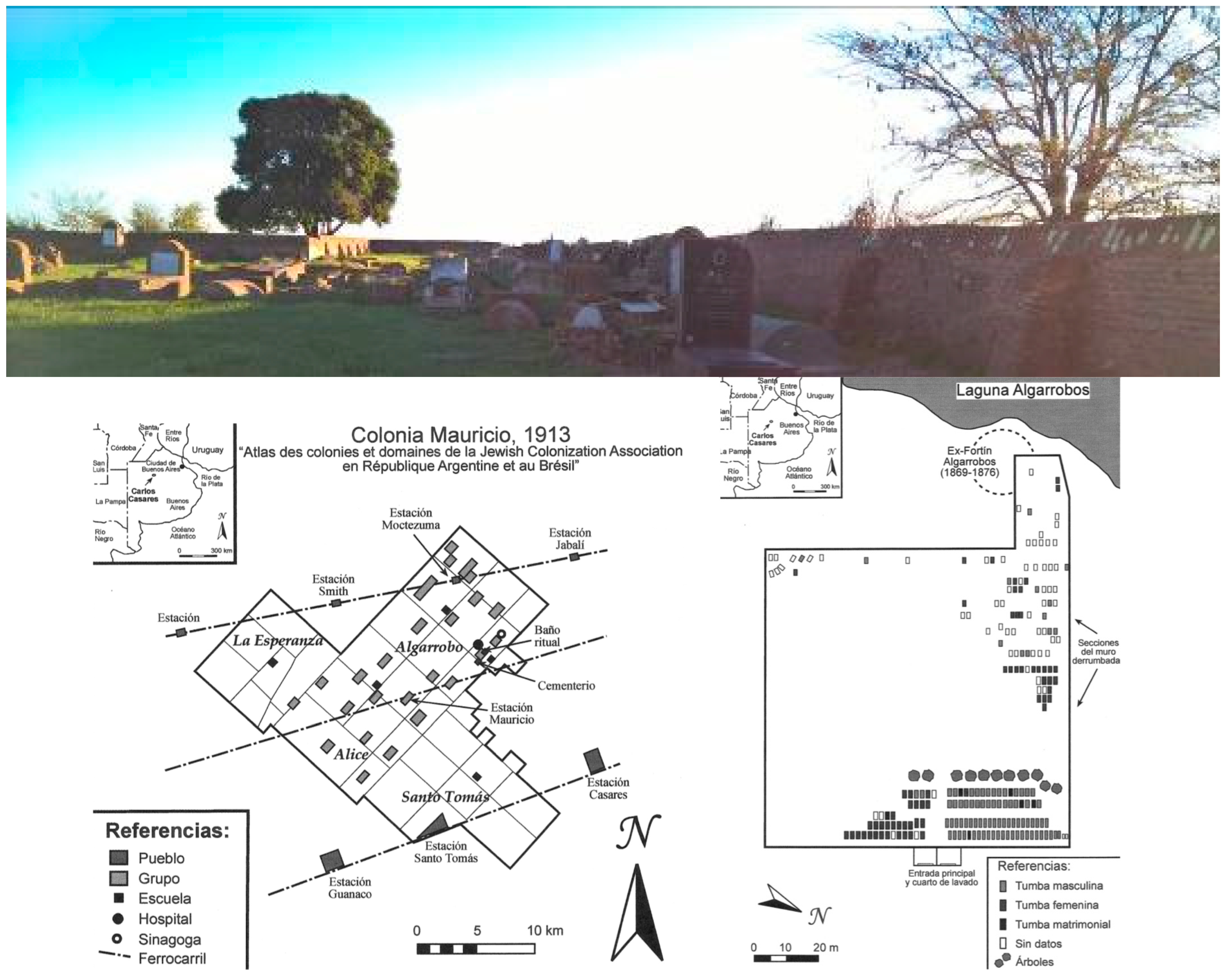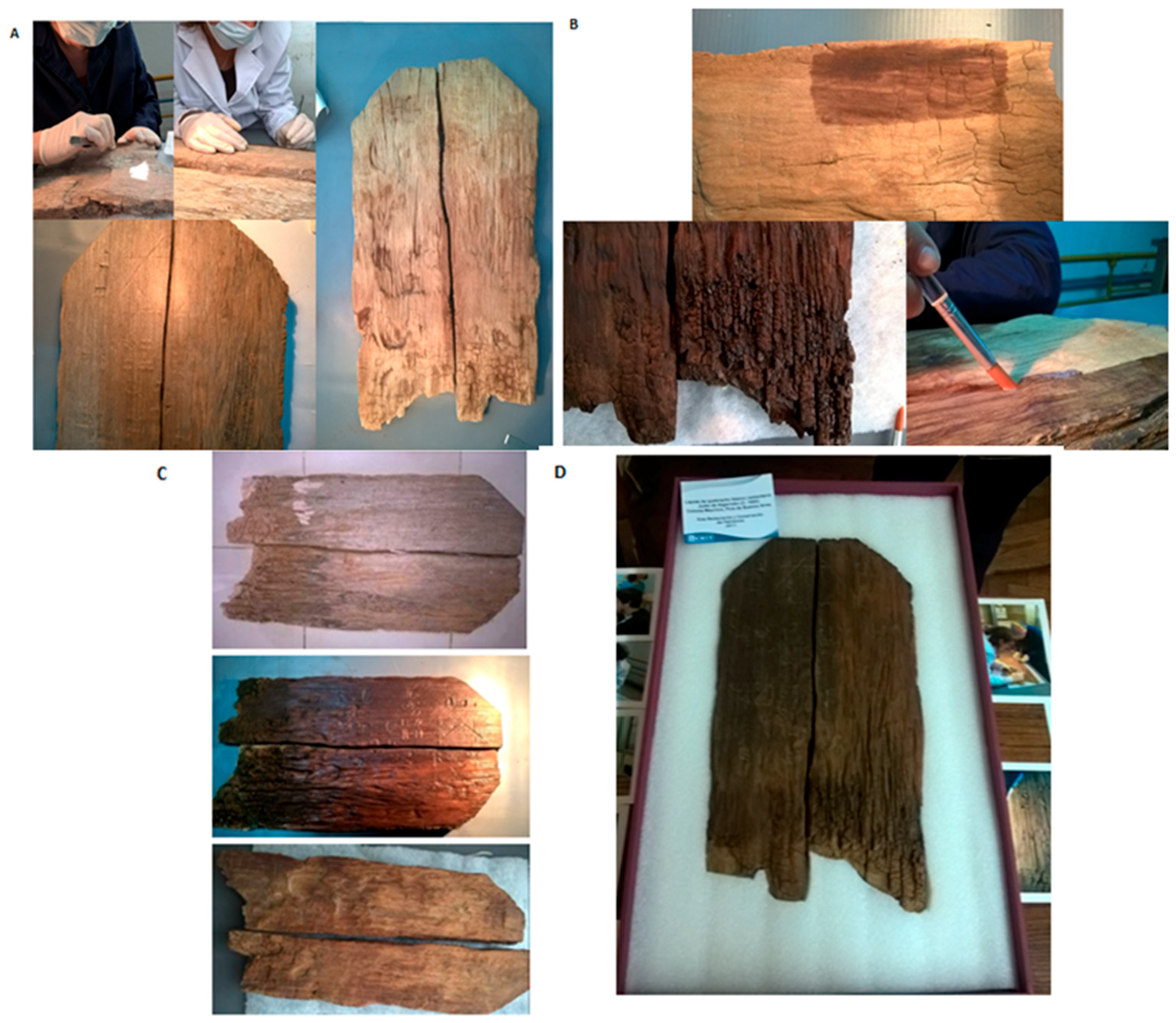Conservation of a Wooden Tomb-Marker from the Jewish Cemetery of Algarrobos in Argentina
Abstract
:1. Introduction
2. State of Condition of the Wooden Tomb-Marker
3. Stages of Conservation
- (i)
- In the first application, the above-defined protective formulation was diluted with turpentine 50/50% v/v formulation/turpentine.
- (ii)
- The following two successive applications were (1) the formulation diluted 25/75% v/v formulation/turpentine and (2) protective formulation without dilution.
- (iii)
- The face of the tomb-marker without graffiti and epitaphs was first exposed to treatment. The drying time between the applications was 24 h. Once the treatment of the face was completed, it was exposed to the seven day drying phase before the treatment of the other face was started. The treatment of the face with graffiti and epitaphs was done in accordance with the same methodology.
- (iv)
- Finally, the tomb-marker was exposed to controlled conditions of temperature and humidity for three weeks to allow correct curing (sol-gel).
4. Results and Discussion
5. Conclusions
Funding
Acknowledgments
Conflicts of Interest
References
- Leoni, J.B.; Acedo, T.; Tamburini, D.; Scarafia, G. Cambio y continuidad en la materialidad funeraria del cementerio judío Algarrobos, Colonia Mauricio (Carlos Casares, Provincia de Buenos Aires). Revista de Arqueología Histórica Argentina y Latinoamericana 2011, 5, 35–65. [Google Scholar]
- Acedo, T.; Schteimberg, D. Cementerio judío de Algarrobos, Sitio Histórico Provincial. Relevamiento e Identificación de Datos; MS. Carlos Casares: Buenos Aires, Argentina, 2005. [Google Scholar]
- Acedo, T. Encuentro con nuestro Patrimonio—La experiencia realizada en la localidad Bonaerense de Carlos Casares. In Actas del XIII Congreso Nacional de Arqueología Argentina, Tomo 2; Facultad de Filosofía y Humanidades, Universidad Nacional de Córdoba: Córdoba, Argentina, 1999; pp. 235–245. [Google Scholar]
- Anderson, T.G. Czech-Catholic cemeteries in East-Central Texas: Material culture and ethnicity in seven rural communities. Mater. Cult. 1993, 25, 1–18. [Google Scholar]
- Aranovich, D. Breve Historia de la Colonia Mauricio (Memory, PhD); Serie Los Pueblos N°3; Editora del Archivo, Ed.; Carlos Casares: Buenos Aires, Argentina, 2002. [Google Scholar]
- Sigwald Carioli, S. Colonia Mauricio, Génesis y Desarrollo de un Ideal, 2nd ed.; Editora del Archivo, Ed.; Centro Cultural José Ingenieros, Archivo Histórico Antonio Maya: Carlos Casares, Argentina, 1991. [Google Scholar]
- Sigwald Carioli, S. Colonia Mauricio: Revalorización de su Trascendencia; Colonia Mauricio, 100 Años, Publicación Oficial de la Comisión Centenario Colonización Judía en Colonia Mauricio: Carlos Casares, Argentina, 1991; Nro 6. Editora del Archivo; Carlos Casares: Buenos Aires, Argentina. [Google Scholar]
- Dulout, L.N.; Flores, O. Costumbres tradicionales funerarias judías y su visualización dentro del Cementerio Israelita de La Plata. In En Patrimonio Cultural en Cementerios y Rituales de la Muerte; Tomo, I., Ed.; Comisión para la preservación del patrimonio histórico cultural de la Ciudad de Buenos Aires: Buenos Aires, Argentina, 2005; pp. 65–77. [Google Scholar]
- Zablotsky, E. Filantropia no Asistencialista: Las Memorias de Boris Garfunkel Sobre Colonia Mauricio; Documento de Trabajo 479; Universidad del CEMA: Buenos Aires, Argentina, 2012; p. 56. [Google Scholar]
- Haim, A. Argentina y la Historia de la Inmigracion Judia 1810–1950; Universitaria Magnes, Ed.; Universidad Hebrea de Jerusalén, AMIA Comunidad de Buenos Aires: Buenos Aires, Argentina, 1983. [Google Scholar]
- Petric, M.P.; Knehtl, B.; Krause, A.; Militz, H.; Pavlic, M.; Pétrissans, M.; Rapp, A.; Tomazic, M.; Welzbacher, C.; Gérardin, P. Wettability of Waterborne Coatings on Chemically and Thermally Modified Pine Wood. J. Coat. Technol. Res. 2007, 4, 203–206. [Google Scholar] [CrossRef]
- Xie, Y.; Krause, A.; Militz, H.; Steuernagel, L.; Mai, C. Effects of hydrophobation treatments of wood particles with an amino alkylsiloxane co-oligomer on properties of the ensuing polypropylene composites. Compos. Part A Appl. Sci. Manuf. 2013, 44, 32–39. [Google Scholar] [CrossRef]
- Daud, N.; Shanks, R. Epoxy–silica composites replicating wood cell structure. Compos. Part A Appl. Sci. Manuf. 2014, 62, 11–15. [Google Scholar] [CrossRef]
- Giudice Carlos, A.; Alfieri, P.V.; Canosa, G. Decay resistance and dimensional stability of Araucaria angustifolia using siloxanes synthesized by sol-gel process. Int. Biodeterior. Biodegrad. 2013, 83, 166–170. [Google Scholar] [CrossRef]
- Canosa, G.; Alfieri, P.V.; Giudice Carlos, A. Dimensional stability, fire performance and decay resistance in wood impregnated with alkylalkoxysilanes. Int. J. Eng. Innov. Technol. 2013, 3, 394–400. [Google Scholar]
- Johannes, K.F. Silicones Reactive Polymers Fundamentals and Applications. In A Concise Guide to Industrial Polymers, 2nd ed.; A Volume in Plastics Design Library; 2013; Chapter 8; pp. 217–233. [Google Scholar]
- Sonowal, J.; Gogoi, P.K. Dimensional Stability, Thermal Degradation and Termite Resistant Studies of Chemically Treated Wood. Int. J. Chem. 2010, 2, 218–225. [Google Scholar] [CrossRef]
- Giudice, C.A.; Canosa, G.; Alfieri, P.V. Nanopinturas Híbridas de alto Contenido de Sólidos para la Protección de Fachadas; 7° Expocongreso REPORT 2014 CABA; CABA: Buenos Aires, Argentina, 2014. [Google Scholar]
- Canosa, G.; Alfieri, P.V.; Caprari, J.; Giudice, C. Performance of wood impregnated with alkoxysilanes. In Proceedings of the Congreso Euro-Americano REHABEND 2016 Sobre Patología de la Construcción, Tecnología de la Rehabilitación y Gestión del Patrimonio, Burgos, España, 24–27 May 2016. [Google Scholar]
- Canosa, G.; Alfieri, P.V.; Giudice, C. Barnices antifúngicos hidrorrepelentes para la protección de maderas de baja densidad. In Proceedings of the 16o Congreso Internacional de Metalurgia y Materiales SAM-CONAMET 2016, Simposio Materiales y Tecnologías para la Industria Metalmecánica y Aeroespacial, Córdoba, Argentina, 22–25 November 2016; pp. 416–417, ISBN 978-950-33-1304-6. [Google Scholar]
- Cui, G.; Liu, J.; Chen, C.; Li, C.; Shi, L. Study on silane impregnation for protection of high performance concrete. Procedia Eng. 2012, 27, 301–307. [Google Scholar]
- Christodoulou, C.; Goodier, C.I.; Ausin, S.A.; Webb, J.; Glass, G.K. Long-term performance of surface impregnation of reinforced concrete structures with silane. Constr. Build. Mater. 2013, 48, 708–716. [Google Scholar] [CrossRef]
- Ferrero, F.; Periolatto, M. Application of fluorinated compounds to cotton fabrics via sol-gel. Appl. Surf. Sci. 2013, 275, 201–207. [Google Scholar] [CrossRef]
- Whelan, M.; Cassidy, J.; Duffy, B. Sol–gel sealing characteristics for corrosion resistance of anodised aluminium. Surf. Coat. Technol. 2013, 235, 86–96. [Google Scholar] [CrossRef]
- Tortorelli, L. Maderas y Bosques Argentinos; EDITORIAL ACME: Buenos Aibes, Argentina, 1956; pp. 1–95. 910p. [Google Scholar]
- Tortorelli, L. Glosario de Términos en Anatomía de Maderas; Revista de Inventario ForestalIV N°1; Administración Nacional de Bosques de Buenos Aires: Buenos Aires, Argentina, 1963; pp. 3–32. [Google Scholar]
- Roig, J.F. Bibliografía Sobre Estructura Demaderas Argentinas; Boletín de Extensión Científica N2; IADIZA: Mendoza, Argentina, 1996. [Google Scholar]
- Jiménez, A.M.; Moglia, J.G. Árboles del Chaco Argentino: Guía para el Reconocimiento Dendrológico; 2003; p. 370. ISBN 987 95852-9-1. [Google Scholar]
- Okan, T.; Köse, N.; Arifoglu, E.; Köse, C. Assessing ecotourism potential of traditional wooden architecture in rural areas: The case of Papart Valley. Sustainability 2016, 8, 974. [Google Scholar] [CrossRef]
- Reinprecht, L.; Joscák, P. Reinforcement of model-damaged wooden elements, Part. 2. Restoration of wooden elements by the extension method using natural wood or epoxy-wood composite. Drevársky Vyskum-Wood Res. 1996, 41, 41–55. [Google Scholar]
- Uzun, Z.; Köse, C.; Köse, N. A multidisciplinary study to reveal the historical value of wooden structures and to develop a conservation approach: Dere and Karlı Mosques in Samsun, Turkey. J. Cult. Heritage 2018. [Google Scholar] [CrossRef]







| Decade | Wood | Marble | Granite | Stone | No Data | Total |
|---|---|---|---|---|---|---|
| 1891–1900 | 1 | 13 | - | - | - | 14 |
| 1901–1910 | 1 | 31 | 1 | 3 | 8 | 44 |
| 1911–1920 | 3 | 27 | 1 | 1 | 2 | 34 |
| 1921–1930 | 1 | 5 | 1 | - | - | 7 |
| 1931–1940 | - | 11 | - | - | 2 | 13 |
| 1941–1950 | - | 8 | 3 | 1 | 2 | 14 |
| 1951–1960 | - | 5 | 1 | - | 2 | 8 |
| 1961–1970 | - | 4 | 6 | - | 3 | 13 |
| 1971–1980 | - | 1 | 1 | - | 2 | 4 |
| 1981–1990 | - | - | 5 | - | 5 | 10 |
| 1991–2000 | - | 1 | 1 | - | 3 | 5 |
| 2001–2010 | 5 | 1 | 3 | - | 59 | 68 |
| No data | 5 | 1 | 3 | - | 59 | 68 |
| Total | 11 | 107 | 23 | 5 | 89 | 235 |
© 2018 by the authors. Licensee MDPI, Basel, Switzerland. This article is an open access article distributed under the terms and conditions of the Creative Commons Attribution (CC BY) license (http://creativecommons.org/licenses/by/4.0/).
Share and Cite
Alfieri, P.V.; Lofeudo, R.; Canosa, G.; Iloro, F.; Traversa, L.P. Conservation of a Wooden Tomb-Marker from the Jewish Cemetery of Algarrobos in Argentina. Heritage 2018, 1, 47-56. https://doi.org/10.3390/heritage1010005
Alfieri PV, Lofeudo R, Canosa G, Iloro F, Traversa LP. Conservation of a Wooden Tomb-Marker from the Jewish Cemetery of Algarrobos in Argentina. Heritage. 2018; 1(1):47-56. https://doi.org/10.3390/heritage1010005
Chicago/Turabian StyleAlfieri, Paula V., Rosana Lofeudo, Guadalupe Canosa, Fabian Iloro, and Luis P. Traversa. 2018. "Conservation of a Wooden Tomb-Marker from the Jewish Cemetery of Algarrobos in Argentina" Heritage 1, no. 1: 47-56. https://doi.org/10.3390/heritage1010005




